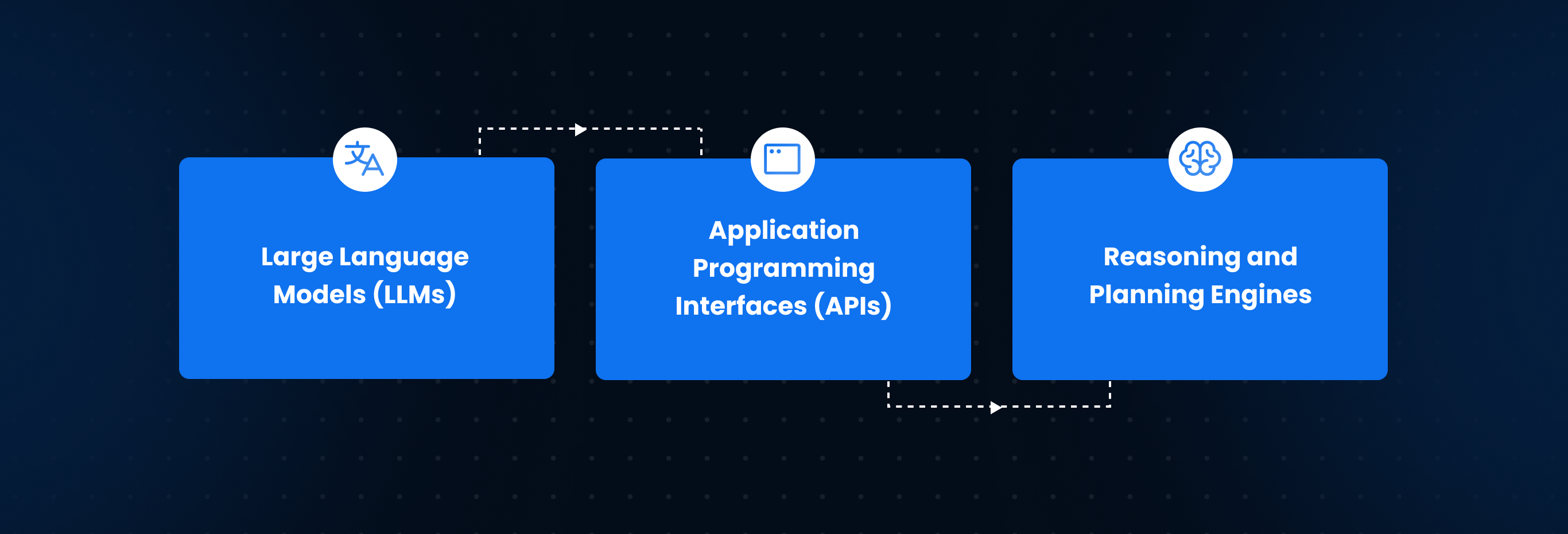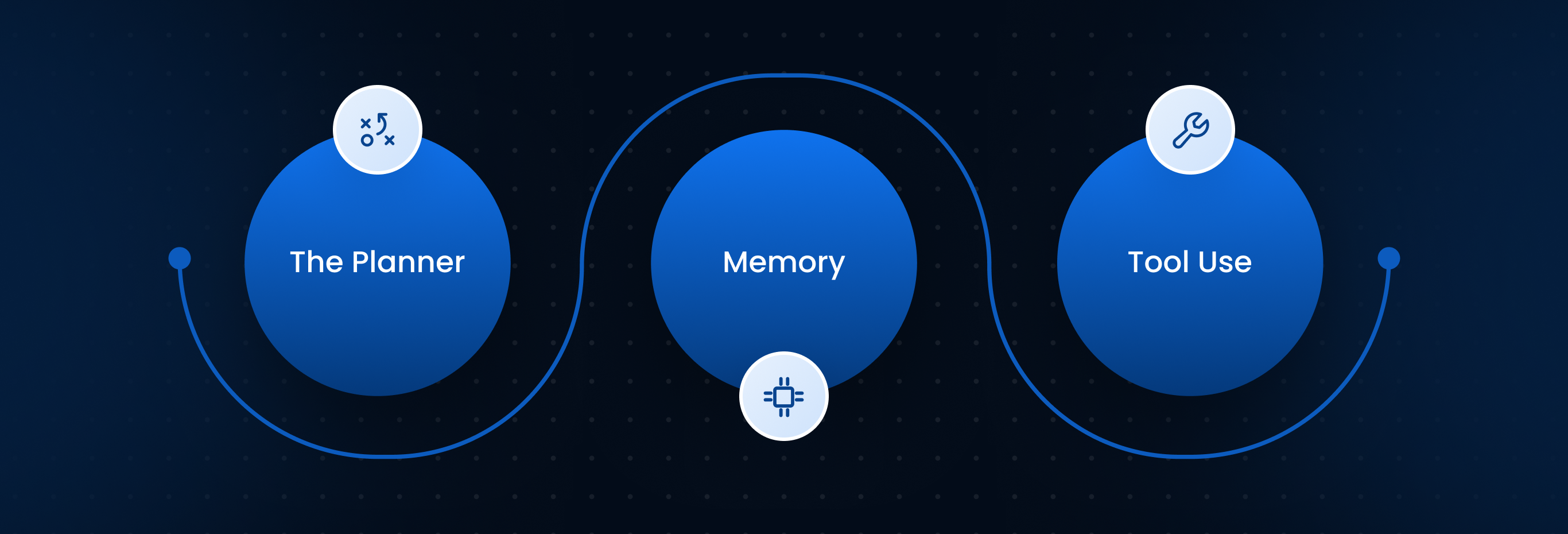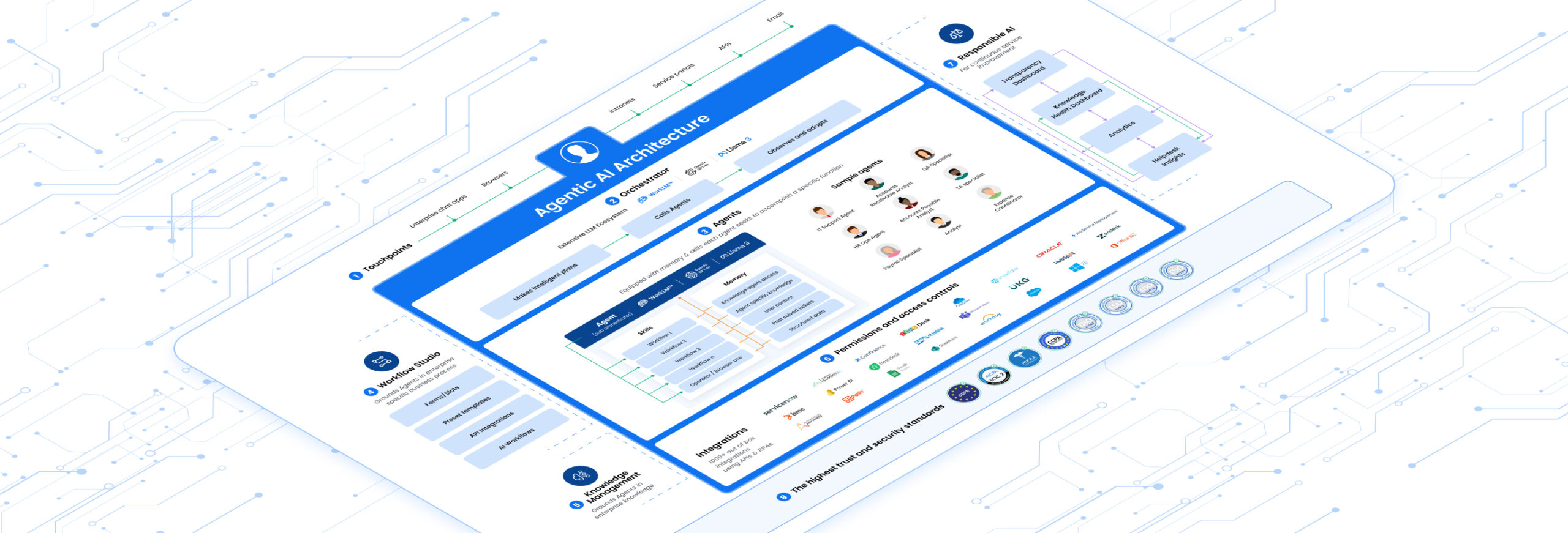Introduction
As a technology leader, you’re constantly balancing innovation with efficiency. You’re likely familiar with the unending stream of employee support tickets for IT, HR, and Finance; each one representing a small but significant drain on productivity. While chatbots offered a glimpse of automation, they often felt like a temporary patch. Now, a more profound shift is underway, driven by a technology that doesn’t just respond but acts: LLM agents. These intelligent systems are moving from the experimental fringe to the core of enterprise strategy, and understanding them is crucial for staying competitive.
This guide will demystify LLM agents, breaking down what they are, how they work, and most importantly, how they deliver tangible value for large enterprises like yours.
What Are LLM Agents?
Let’s use an analogy you’re familiar with. Think of a traditional chatbot as a customer service rep at a call center with a very specific script. They can answer predefined questions, but if you ask for something complex, they have to escalate the call.
In contrast, an LLM agent is like your most resourceful team lead. This person doesn’t just follow a script; they listen to your problem, think critically, decide on a plan, and then use the tools at their disposal (like accessing a database, sending an email, or interfacing with another software) to solve the problem from start to finish.
Put simply, LLM agents are autonomous systems built around a large language model (the “brain”) that can reason, plan, and execute multi-step tasks to achieve a specific goal. They don’t just provide information; they perform actions.
Key Technologies Powering LLM Agents
So, what’s the magic behind the curtain? It’s not just one thing but a powerful combination of technologies working in harmony.
- Large Language Models (LLMs): This is the core intelligence. An LLM, like OpenAI’s GPT series or Google’s Gemini, provides the reasoning, comprehension, and language generation capabilities. It’s the “brain” that understands the user’s intent.
- Application Programming Interfaces (APIs): These are the “hands and feet” of LLM agents. APIs allow the agent to connect to and interact with other software and tools. For example, an agent might use a ticketing system’s API to update a ticket, a human resources system’s API to check vacation balances, or a cloud provider’s API to restart a server.
- Reasoning and Planning Engines: This is the logic layer that translates a user’s goal into a sequence of actionable steps. When an employee says, “My laptop is slow,” the engine helps the agent create a plan: first, run diagnostics; second, check for software updates; third, if unresolved, create a ticket for hardware replacement.

Core Components of an LLM Agent System
To better understand how LLM agents operate, it helps to know their fundamental components. While architectures vary, most systems include these three elements:
- The Planner: This component takes the user’s request and breaks it down into a logical, step-by-step plan. It determines which tools are needed and in what order they should be used.
- Memory: Unlike a simple chatbot that forgets a conversation once it’s over, LLM agents have memory. They can recall past interactions (short-term memory) and access vast knowledge bases (long-term memory) to provide context and make more informed decisions.
- Tool Use: This is the agent’s ability to execute actions. Based on the planner’s instructions, the agent selects and uses the appropriate tool, such as looking up a policy in a document, resetting a password via an identity management system, or ordering new equipment through a procurement portal.

Popular Architectures and Frameworks for LLM Agents
Building robust LLM agents from scratch is a significant undertaking. Consequently, several frameworks have emerged to simplify their development. You may hear your technical teams mention frameworks like LangChain or LlamaIndex, which provide standardized toolkits for connecting LLMs with other data sources and APIs. Another popular concept is the ReAct (Reason and Act) architecture, which pioneers the method of having the model “think out loud” to reason through a problem and then choose an action, closely mimicking human problem-solving. Understanding that these foundational tools exist is key to appreciating how mature the development of LLM agents has become.
Use Cases of LLM Agents in Enterprises
This is where the theoretical meets the practical. For large US companies, the applications for resolving internal tickets are immediate and impactful.
- IT Support: Imagine an employee needs access to a specific software. Instead of creating a ticket and waiting, they can ask the agent. The LLM agent can then verify the employee’s role, check for license availability, grant access through the identity management tool, and close the ticket automatically. Other common use cases include automated password resets, device troubleshooting, and server status checks.
- HR Assistance: An employee asks, “How much paid time off do I have left, and can I request next Friday off?” The agent can access the HR information system to provide the balance and then use the system’s API to submit the time-off request for manager approval, all within a single conversation.
- Finance Queries: A department head needs a report on their team’s travel expenses for the last quarter. The LLM agent can query the financial software, generate the report, and deliver it directly to the user, saving hours of manual work for the finance team.
Benefits of Implementing LLM Agents
Adopting these advanced systems delivers clear, measurable benefits that resonate at the executive level.
-
Drastic Cost Reduction: By automating resolutions for a high volume of routine tickets, you reduce the operational cost per ticket and free up your human support staff.
-
Enhanced Employee Experience: Employees get instant, 24/7 support without waiting in a queue. This immediate problem-solving capability reduces frustration and downtime, directly improving productivity and satisfaction.
-
Unmatched Scalability: LLM agents can handle thousands of concurrent conversations without a drop in performance, allowing you to scale your support capabilities without scaling your headcount.
-
Strategic Re-focusing of Talent: With autonomous agents handling repetitive tasks, your skilled IT, HR, and Finance professionals can focus on high-value, strategic initiatives that drive the business forward.
Challenges and Limitations of LLM Agents
Of course, no technology is a silver bullet. As a technology leader, it’s vital to approach implementation with a clear understanding of the challenges.
- Security and Data Privacy: Granting an agent access to enterprise systems requires an extremely robust security framework to prevent unauthorized actions and protect sensitive data.
- Model “Hallucinations”: LLMs can occasionally generate incorrect or nonsensical information. In an enterprise context, this requires guardrails and verification mechanisms to ensure accuracy.
- Integration Complexity: Connecting an agent to dozens of legacy and modern applications is a significant technical hurdle that requires careful architectural planning.
- Cost of Operation: The computational resources needed to run powerful LLM agents can be substantial, requiring a clear ROI analysis.
The Future of LLM Agents
Looking ahead to 2025 and beyond, the capabilities of LLM agents will only expand. We are moving toward proactive support, where an agent might detect that an employee’s laptop is running low on memory and proactively suggest an upgrade before a ticket is even filed. Furthermore, these systems will offer hyper-personalized interactions, understanding an individual’s role, history, and preferences to provide uniquely tailored support. The complexity of tasks these agents can handle will also grow, moving from simple, single-application actions to complex workflows that span multiple departments.
Leena AI’s Approach to Building Enterprise-Ready LLM Agents
While the challenges of implementation are real, they are not insurmountable. This is where Leena AI’s approach to building enterprise-ready LLM agents comes in. We understand that large companies can’t afford to experiment with unsecured, unreliable, or un-governed AI. Our platform is built from the ground up with the enterprise in mind.
We address the key challenges head-on by providing:
-
Robust Security and Governance: We implement strict access controls, data encryption, and audit logs to ensure your company’s information remains secure.
-
Seamless, Pre-built Integrations: Our extensive library of integrations with leading enterprise software like Workday, ServiceNow, and Microsoft Azure means we don’t have to start from scratch. This drastically reduces implementation time and complexity.
-
Domain-Specific Expertise: Our LLM agents are not generic; they are fine-tuned on vast datasets specific to IT, HR, and Finance. In our pioneering “Agentic AI in IT” solutions, for example, our agent already understands the nuances of tasks like user provisioning and de-provisioning, software license management, and security group administration. This specialization ensures higher accuracy and a better user experience right out of the box.
Ultimately, Leena AI creates value by delivering LLM agents that are not just powerful but also practical, secure, and ready to solve your most pressing employee support challenges from day one.
Frequently Asked Questions (FAQs)
1. What's the main difference between traditional chatbots and LLM agents?
A traditional chatbot follows a fixed script or decision tree. In contrast, LLM agents can understand open-ended requests, reason through a problem, create a unique plan, and use external tools to execute that plan and solve the issue autonomously.
2. How secure are LLM agents with sensitive company data?
Enterprise-grade LLM agents, like those from Leena AI, are built on a foundation of security. This includes role-based access control, ensuring the agent only accesses data it’s permitted to see, data encryption in transit and at rest, and comprehensive audit trails of every action taken.
3. Can LLM agents integrate with our company’s existing software?
Yes. A core feature of effective LLM agents is their ability to integrate with other systems via APIs. This allows them to connect with your existing ticketing systems, HR platforms, financial software, and other enterprise tools to fetch information and perform actions.
4. What is the typical implementation timeline for enterprise-grade LLM agents?
With a platform that offers pre-built integrations and domain-specific models, implementation can be surprisingly fast, often taking weeks rather than months. The timeline depends on the complexity and number of systems you want the LLM agents to connect with.
5. How do you measure the success and ROI of LLM agents?
Success is measured through key performance indicators (KPIs) like autonomous resolution rate (the percentage of tickets solved without human intervention), reduction in average resolution time, cost per ticket reduction, and improvements in employee satisfaction scores (ESAT).
6. Do LLM agents replace human support teams?
No, they augment them. By automating high-volume, repetitive tasks, LLM agents free up your human experts to focus on complex, high-touch, and strategic issues where their skills are most valuable, transforming them from ticket-solvers to strategic advisors.
7. How do LLM agents handle tasks they haven't been specifically trained for?
Because they are built on powerful large language models, LLM agents have strong “zero-shot” or “few-shot” learning capabilities. This means they can often reason their way through novel problems by breaking them down and using the tools they have, even if they haven’t seen that exact request before.













